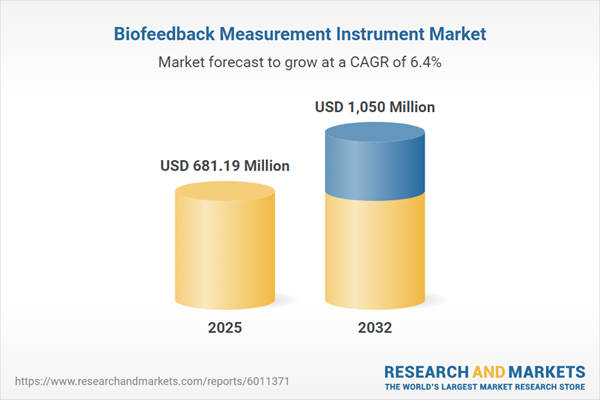Speak directly to the analyst to clarify any post sales queries you may have.
Biofeedback measurement instruments are reshaping healthcare and performance optimization by enabling precise, real-time monitoring of physiological data. As organizations aim to unlock their full potential in wellness and therapeutic sectors, understanding this dynamic market is essential to guide informed investment and innovation strategies.
Market Snapshot: Biofeedback Measurement Instrument Market
The Biofeedback Measurement Instrument Market grew from USD 641.60 million in 2024 to USD 681.19 million in 2025. It is expected to continue growing at a CAGR of 6.35%, reaching USD 1.05 billion by 2032.
Market Scope & Segmentation
This report offers comprehensive insight into the Biofeedback Measurement Instrument Market, covering the full scope of products, technologies, channels, applications, end-users, and geographies driving industry change.
- Product Types: Clinical instruments including EEG devices, EMG devices, neurofeedback, respiration, skin conductance, and temperature feedback devices; desktop-based instruments; sensor modules such as heart rate and temperature sensors; software solutions for diagnostics and monitoring.
- Technologies: Wired connectivity; wireless connectivity via Bluetooth; wireless connectivity via Wi-Fi.
- Sales Channels: Direct sales through B2B or institutional contracts; offline retail outlets; online retail via manufacturers’ websites and third-party platforms.
- Applications: Home healthcare; occupational therapy; pain management for chronic and post-surgical patients; rehabilitation; sports medicine including injury prevention and performance enhancement; stress management.
- End-Users: Clinics; fitness centers (encompassing coaches and trainers); home users; hospitals; research institutes; wellness centers.
- Regions: Americas (North America—United States, Canada, Mexico; Latin America—Brazil, Argentina, Chile, Colombia, Peru); Europe, Middle East & Africa (including United Kingdom, Germany, France, and key Middle Eastern and African markets); Asia-Pacific (coverage of China, India, Japan, Australia, and additional high-growth markets).
- Key Companies: Alive Technologies, BrainMaster Technologies, Compumedics Limited, Delsys Incorporated, ELMIKO Medical Equipment, Emotiv Inc., GENEQ Inc., Giger MD, HeartMath LLC, Hocoma AG, J&J Engineering, Medtronic PLC, Mind Alive Inc., Mind Media B.V, mTrigger, Natus Medical Incorporated, Neurobit Systems, neuroCare Group AG, NeuroMetrix Inc., NeuroSky Inc., Noraxon, OpenBCI, QX World KFT, Sieso, Somatic Vision Inc., Thought Technology Ltd.
Key Takeaways for Senior Decision-Makers
- Biofeedback instruments are a driving force in both clinical therapeutics and the rapidly expanding consumer wellness sector, fostering adoption across diverse segments.
- Advancements such as sensor miniaturization, wireless connectivity, and AI-powered analytics are enhancing data accuracy and user experience for healthcare professionals and end-users.
- Integration with telehealth platforms and immersive technologies like virtual reality is accelerating remote monitoring, improved adherence, and scalable intervention delivery.
- Differentiated product design remains essential to address varying needs of clinical, research, and wellness settings, particularly as demand for personalized and home-based solutions rises.
- Strategic partnerships with research institutions and medical networks help validate efficacy, navigate complex regulations, and create new commercialization channels.
- Competitive intensity is shaped by established med-tech leaders and agile entrants, each leveraging unique approaches from proprietary sensor features to modular hardware and subscription-based software models.
Tariff Impact
Recent United States tariff policies affecting electronic components and medical device imports have increased input costs for manufacturers. Leading firms are reconsidering supply chain strategies by focusing on regional sourcing and local assembly to stabilize margins and ensure consistent supply. Component diversification and investment in proprietary sensor technologies further help mitigate pricing pressures in a shifting trade environment.
Methodology & Data Sources
This report combines qualitative and quantitative market intelligence to provide senior leaders with actionable insight. Primary research included stakeholder interviews with clinicians and technology developers, while secondary sources such as regulatory filings, academic papers, and patent databases were validated through rigorous cross-referencing. Statistical models underpinned quantification of adoption rates, supply chain dynamics, and channel performance.
Why This Report Matters
- Enables board-level market planning and acquisition targeting by mapping evolving technology trends and end-user demand.
- Provides clarity on regional opportunities and competitive differentiation essential to global expansion and product innovation.
- Informs risk mitigation efforts in light of regulatory shifts and trade-related cost challenges, supporting faster and more resilient strategy execution.
Conclusion
The Biofeedback Measurement Instrument Market is advancing through continuous technological progress and new application areas. Robust analysis ensures that organizations can confidently align strategy, investment, and product development for lasting impact in this growing field.
Additional Product Information:
- Purchase of this report includes 1 year online access with quarterly updates.
- This report can be updated on request. Please contact our Customer Experience team using the Ask a Question widget on our website.
Table of Contents
3. Executive Summary
4. Market Overview
7. Cumulative Impact of Artificial Intelligence 2025
Companies Mentioned
The companies profiled in this Biofeedback Measurement Instrument market report include:- Alive Technologies Pty Ltd.
- BrainMaster Technologies, Inc.
- Compumedics Limited
- Delsys Incorporated
- ELMIKO Medical Equipment
- Emotiv Inc.
- GENEQ, Inc.
- Giger MD
- HeartMath LLC
- Hocoma AG
- J&J Engineering
- Medtronic PLC
- Mind Alive Inc.
- Mind Media B.V
- mTrigger
- Natus Medical Incorporated
- Neurobit Systems
- neuroCare Group AG
- NeuroMetrix, Inc.
- NeuroSky, Inc.
- Noraxon
- OpenBCI
- QX World KFT
- Sieso
- Somatic Vision Inc.
- Thought Technology Ltd.
Table Information
| Report Attribute | Details |
|---|---|
| No. of Pages | 188 |
| Published | November 2025 |
| Forecast Period | 2025 - 2032 |
| Estimated Market Value ( USD | $ 681.19 Million |
| Forecasted Market Value ( USD | $ 1050 Million |
| Compound Annual Growth Rate | 6.3% |
| Regions Covered | Global |
| No. of Companies Mentioned | 27 |









